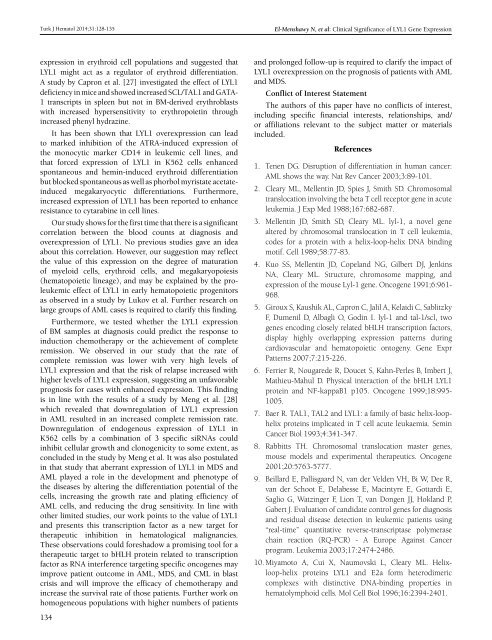Turkish Journal of Hematology Volume: 31 - Issue: 2
Create successful ePaper yourself
Turn your PDF publications into a flip-book with our unique Google optimized e-Paper software.
Turk J Hematol 2014;<strong>31</strong>:128-135<br />
El-Menshawy N, et al: Clinical Significance <strong>of</strong> LYL1 Gene Expression<br />
expression in erythroid cell populations and suggested that<br />
LYL1 might act as a regulator <strong>of</strong> erythroid differentiation.<br />
A study by Capron et al. [27] investigated the effect <strong>of</strong> LYL1<br />
deficiency in mice and showed increased SCL/TAL1 and GATA-<br />
1 transcripts in spleen but not in BM-derived erythroblasts<br />
with increased hypersensitivity to erythropoietin through<br />
increased phenyl hydrazine.<br />
It has been shown that LYL1 overexpression can lead<br />
to marked inhibition <strong>of</strong> the ATRA-induced expression <strong>of</strong><br />
the monocytic marker CD14 in leukemic cell lines, and<br />
that forced expression <strong>of</strong> LYL1 in K562 cells enhanced<br />
spontaneous and hemin-induced erythroid differentiation<br />
but blocked spontaneous as well as phorbol myristate acetateinduced<br />
megakaryocytic differentiations. Furthermore,<br />
increased expression <strong>of</strong> LYL1 has been reported to enhance<br />
resistance to cytarabine in cell lines.<br />
Our study shows for the first time that there is a significant<br />
correlation between the blood counts at diagnosis and<br />
overexpression <strong>of</strong> LYL1. No previous studies gave an idea<br />
about this correlation. However, our suggestion may reflect<br />
the value <strong>of</strong> this expression on the degree <strong>of</strong> maturation<br />
<strong>of</strong> myeloid cells, erythroid cells, and megakaryopoiesis<br />
(hematopoietic lineage), and may be explained by the proleukemic<br />
effect <strong>of</strong> LYL1 in early hematopoietic progenitors<br />
as observed in a study by Lukov et al. Further research on<br />
large groups <strong>of</strong> AML cases is required to clarify this finding.<br />
Furthermore, we tested whether the LYL1 expression<br />
<strong>of</strong> BM samples at diagnosis could predict the response to<br />
induction chemotherapy or the achievement <strong>of</strong> complete<br />
remission. We observed in our study that the rate <strong>of</strong><br />
complete remission was lower with very high levels <strong>of</strong><br />
LYL1 expression and that the risk <strong>of</strong> relapse increased with<br />
higher levels <strong>of</strong> LYL1 expression, suggesting an unfavorable<br />
prognosis for cases with enhanced expression. This finding<br />
is in line with the results <strong>of</strong> a study by Meng et al. [28]<br />
which revealed that downregulation <strong>of</strong> LYL1 expression<br />
in AML resulted in an increased complete remission rate.<br />
Downregulation <strong>of</strong> endogenous expression <strong>of</strong> LYL1 in<br />
K562 cells by a combination <strong>of</strong> 3 specific siRNAs could<br />
inhibit cellular growth and clonogenicity to some extent, as<br />
concluded in the study by Meng et al. It was also postulated<br />
in that study that aberrant expression <strong>of</strong> LYL1 in MDS and<br />
AML played a role in the development and phenotype <strong>of</strong><br />
the diseases by altering the differentiation potential <strong>of</strong> the<br />
cells, increasing the growth rate and plating efficiency <strong>of</strong><br />
AML cells, and reducing the drug sensitivity. In line with<br />
other limited studies, our work points to the value <strong>of</strong> LYL1<br />
and presents this transcription factor as a new target for<br />
therapeutic inhibition in hematological malignancies.<br />
These observations could foreshadow a promising tool for a<br />
therapeutic target to bHLH protein related to transcription<br />
factor as RNA interference targeting specific oncogenes may<br />
improve patient outcome in AML, MDS, and CML in blast<br />
crisis and will improve the efficacy <strong>of</strong> chemotherapy and<br />
increase the survival rate <strong>of</strong> those patients. Further work on<br />
homogeneous populations with higher numbers <strong>of</strong> patients<br />
and prolonged follow-up is required to clarify the impact <strong>of</strong><br />
LYL1 overexpression on the prognosis <strong>of</strong> patients with AML<br />
and MDS.<br />
Conflict <strong>of</strong> Interest Statement<br />
The authors <strong>of</strong> this paper have no conflicts <strong>of</strong> interest,<br />
including specific financial interests, relationships, and/<br />
or affiliations relevant to the subject matter or materials<br />
included.<br />
References<br />
1. Tenen DG. Disruption <strong>of</strong> differentiation in human cancer:<br />
AML shows the way. Nat Rev Cancer 2003;3:89-101.<br />
2. Cleary ML, Mellentin JD, Spies J, Smith SD. Chromosomal<br />
translocation involving the beta T cell receptor gene in acute<br />
leukemia. J Exp Med 1988;167:682-687.<br />
3. Mellentin JD, Smith SD, Cleary ML. lyl-1, a novel gene<br />
altered by chromosomal translocation in T cell leukemia,<br />
codes for a protein with a helix-loop-helix DNA binding<br />
motif. Cell 1989;58:77-83.<br />
4. Kuo SS, Mellentin JD, Copeland NG, Gilbert DJ, Jenkins<br />
NA, Cleary ML. Structure, chromosome mapping, and<br />
expression <strong>of</strong> the mouse Lyl-1 gene. Oncogene 1991;6:961-<br />
968.<br />
5. Giroux S, Kaushik AL, Capron C, Jalil A, Kelaidi C, Sablitzky<br />
F, Dumenil D, Albagli O, Godin I. lyl-1 and tal-1/scl, two<br />
genes encoding closely related bHLH transcription factors,<br />
display highly overlapping expression patterns during<br />
cardiovascular and hematopoietic ontogeny. Gene Expr<br />
Patterns 2007;7:215-226.<br />
6. Ferrier R, Nougarede R, Doucet S, Kahn-Perles B, Imbert J,<br />
Mathieu-Mahul D. Physical interaction <strong>of</strong> the bHLH LYL1<br />
protein and NF-kappaB1 p105. Oncogene 1999;18:995-<br />
1005.<br />
7. Baer R. TAL1, TAL2 and LYL1: a family <strong>of</strong> basic helix-loophelix<br />
proteins implicated in T cell acute leukaemia. Semin<br />
Cancer Biol 1993;4:341-347.<br />
8. Rabbitts TH. Chromosomal translocation master genes,<br />
mouse models and experimental therapeutics. Oncogene<br />
2001;20:5763-5777.<br />
9. Beillard E, Pallisgaard N, van der Velden VH, Bi W, Dee R,<br />
van der Schoot E, Delabesse E, Macintyre E, Gottardi E,<br />
Saglio G, Watzinger F, Lion T, van Dongen JJ, Hokland P,<br />
Gabert J. Evaluation <strong>of</strong> candidate control genes for diagnosis<br />
and residual disease detection in leukemic patients using<br />
“real-time” quantitative reverse-transcriptase polymerase<br />
chain reaction (RQ-PCR) - A Europe Against Cancer<br />
program. Leukemia 2003;17:2474-2486.<br />
10. Miyamoto A, Cui X, Naumovski L, Cleary ML. Helixloop-helix<br />
proteins LYL1 and E2a form heterodimeric<br />
complexes with distinctive DNA-binding properties in<br />
hematolymphoid cells. Mol Cell Biol 1996;16:2394-2401.<br />
134

















